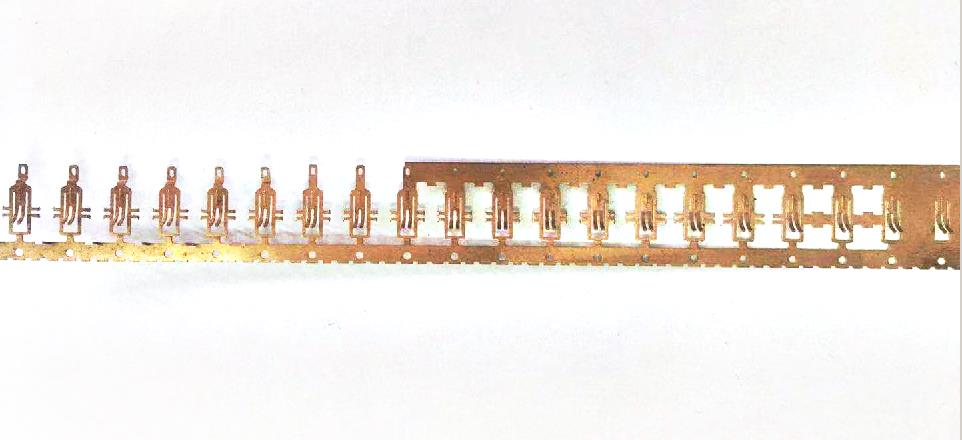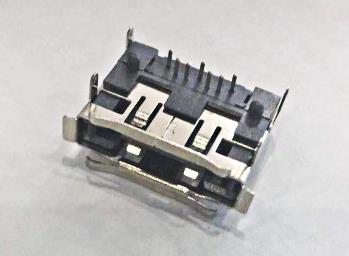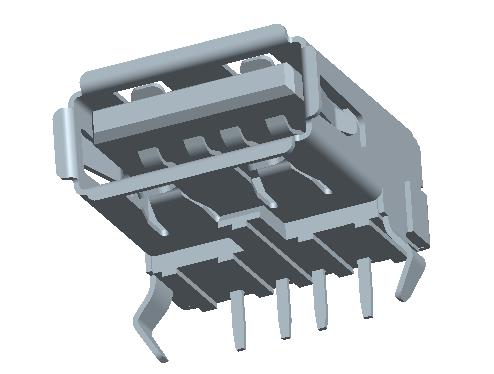FOCUSES ON PLASTIC INJECTION AND MOLD DESIGN.

DONGGUAN LONGKE ELECTRONIC TECHNOLOGY CO., LTD.
Focus on R & D, production and marketing of precision connectors, electronic connecting lines, metal stamping, mold design
Enterprise mailbox
sales@longke-china.com
NEWS
FOCUSED ON CONNECTOR
主页 > Home > News > Knowledge Encyclopedia >
Knowledge Encyclopedia
Use USB to charge the battery. Battery management interface circuit
- Release date:19-10-23 10:16
- Clicks:93
Summary
Universal serial bus (USB) port is a bidirectional data port with power and ground. USB can connect all kinds of peripheral devices, including external drive, storage device, keyboard, mouse, wireless interface, camera and camera, MP3 player and countless electronic devices. Many of these devices are battery powered, some with built-in batteries. For the design of battery charging, USB, which is widely used, brings both opportunities and challenges. This paper describes how to interface a simple battery charger with USB power supply. This paper reviews the characteristics of USB power bus, including voltage, current limit, surge current, connector and cable connection. At the same time, NiMH and Li battery technology, charging method and charging termination technology are introduced. A complete example circuit is given to realize the intelligent charging of NiMH battery by USB port, and the charging data is given.
USB characteristics
USB bus can provide power for low power electronic devices. The bus power supply is isolated from the power grid and has good stability. However, the available current is limited, and there is a latent problem of interoperability between the load and the host or power supply.
The USB port is composed of 90 Ω bidirectional differential shielded twisted pair, VBUS (+ 5V power supply) and ground. The four wires are shielded by an inner aluminum foil shield and an outer braided screen. The latest USB specification standard is version 2.0, which can be obtained free of charge from USB organization. In order to fully comply with the standard, a functional controller is needed to realize the two-way communication between the equipment and the host. The specification defines a unit load of 100mA (maximum). The maximum current allowed to be drawn by any equipment is 5 unit load.
USB port can be divided into low-power port and high-power port. The low-power port can provide 1 unit load current, and the high-power port can provide 5 unit load current at most. When the device is just connected to the USB port, the enumeration process identifies the device and determines its load requirements. In this process, only the equipment is allowed to draw current of up to 1 unit load from the host. After enumeration, if the host's power management software allows, the high-power equipment can draw more current.
Some host systems (including downstream USB hubs) provide current limiting functions through fuses or active current detectors. If the USB device draws a large current (more than 1 unit load) from the USB port without enumeration, the host will detect the over-current state and close one or more USB ports in use. Many USB devices supplied on the market, including independent battery chargers, do not have functional controllers to handle the enumeration process, but the current absorbed is more than 100mA. Under such improper conditions, these devices may cause problems in the host. For example, if a device that draws 500 mA current is plugged into a USB hub powered by the bus, and the correct enumeration process is not carried out, the hub port and the host port may be overloaded at the same time.
When the host control system adopts advanced power management, the situation will be more complex, especially for notebook computers, which always want the port current to be as low as possible. In some power-saving modes, the computer will issue a suspend command to the USB device, and then it will assume that the device is in the low-power mode. It is always a good practice to include a functional controller in the device that can communicate with the host, even for low-power devices.
USB 2.0 specification is very comprehensive, which specifies the quality of power supply, connector structure, cable material, allowable voltage drop, surge current, etc. Low current and high current ports have different power supply specifications. This is mainly determined by the voltage drop on the connector and cable between the host and load, and includes the voltage drop generated on the hub powered by USB. The host, including the computer or self powered USB hub, has a large current port, which can provide a maximum current of 500mA. Passive, bus powered USB hub with low current port. Table 1 lists the voltage tolerance allowed by the upstream (power) pin of USB high current and low current ports.
Table 1. USB 2.0 power quality standard
Parameter requirement
DC voltage, high power port * 4.75V to 5.25V
DC voltage, low power port * 4.40v to 5.25V
Maximum quiet current (low power, suspend mode) 500 μ a
Maximum quiet current (high power, suspend mode) 2500 μ a
Maximum allowable input capacity (load side) 10 μ f
Minimum required output capacity (host side) 120 μ f ± 20%
Maximum allowable inrush charge into load 50 μ C
*These metrics apply to the connector pins of the upstream host or hub ports. I x r drop on cables and connectors to be considered separately.
In the USB 2.0 compliant host, the upstream end of the high-power port has 120 μ F, low ESR capacitance. The input capacitance of the connected USB device is limited to 10 μ F. in the initial load connection stage, the maximum charge absorbed by the load from the host (or self powered hub) is allowed to be 50 μ C. As a result, when the new device is connected to the USB port, the transient voltage drop of the upstream port is less than 0.5V. If a larger input capacitance is required for normal operation of the load, a surge current limiter must be provided to ensure that the current will not exceed 100mA when charging the larger capacitance.
When the USB port is equipped with a bus powered USB hub, and the hub is connected with a low-power device, the allowable DC voltage drop on the USB port is shown in Figure 1. When the high-power load is connected to the hub powered by the bus
Universal serial bus (USB) port is a bidirectional data port with power and ground. USB can connect all kinds of peripheral devices, including external drive, storage device, keyboard, mouse, wireless interface, camera and camera, MP3 player and countless electronic devices. Many of these devices are battery powered, some with built-in batteries. For the design of battery charging, USB, which is widely used, brings both opportunities and challenges. This paper describes how to interface a simple battery charger with USB power supply. This paper reviews the characteristics of USB power bus, including voltage, current limit, surge current, connector and cable connection. At the same time, NiMH and Li battery technology, charging method and charging termination technology are introduced. A complete example circuit is given to realize the intelligent charging of NiMH battery by USB port, and the charging data is given.
USB characteristics
USB bus can provide power for low power electronic devices. The bus power supply is isolated from the power grid and has good stability. However, the available current is limited, and there is a latent problem of interoperability between the load and the host or power supply.
The USB port is composed of 90 Ω bidirectional differential shielded twisted pair, VBUS (+ 5V power supply) and ground. The four wires are shielded by an inner aluminum foil shield and an outer braided screen. The latest USB specification standard is version 2.0, which can be obtained free of charge from USB organization. In order to fully comply with the standard, a functional controller is needed to realize the two-way communication between the equipment and the host. The specification defines a unit load of 100mA (maximum). The maximum current allowed to be drawn by any equipment is 5 unit load.
USB port can be divided into low-power port and high-power port. The low-power port can provide 1 unit load current, and the high-power port can provide 5 unit load current at most. When the device is just connected to the USB port, the enumeration process identifies the device and determines its load requirements. In this process, only the equipment is allowed to draw current of up to 1 unit load from the host. After enumeration, if the host's power management software allows, the high-power equipment can draw more current.
Some host systems (including downstream USB hubs) provide current limiting functions through fuses or active current detectors. If the USB device draws a large current (more than 1 unit load) from the USB port without enumeration, the host will detect the over-current state and close one or more USB ports in use. Many USB devices supplied on the market, including independent battery chargers, do not have functional controllers to handle the enumeration process, but the current absorbed is more than 100mA. Under such improper conditions, these devices may cause problems in the host. For example, if a device that draws 500 mA current is plugged into a USB hub powered by the bus, and the correct enumeration process is not carried out, the hub port and the host port may be overloaded at the same time.
When the host control system adopts advanced power management, the situation will be more complex, especially for notebook computers, which always want the port current to be as low as possible. In some power-saving modes, the computer will issue a suspend command to the USB device, and then it will assume that the device is in the low-power mode. It is always a good practice to include a functional controller in the device that can communicate with the host, even for low-power devices.
USB 2.0 specification is very comprehensive, which specifies the quality of power supply, connector structure, cable material, allowable voltage drop, surge current, etc. Low current and high current ports have different power supply specifications. This is mainly determined by the voltage drop on the connector and cable between the host and load, and includes the voltage drop generated on the hub powered by USB. The host, including the computer or self powered USB hub, has a large current port, which can provide a maximum current of 500mA. Passive, bus powered USB hub with low current port. Table 1 lists the voltage tolerance allowed by the upstream (power) pin of USB high current and low current ports.
Table 1. USB 2.0 power quality standard
Parameter requirement
DC voltage, high power port * 4.75V to 5.25V
DC voltage, low power port * 4.40v to 5.25V
Maximum quiet current (low power, suspend mode) 500 μ a
Maximum quiet current (high power, suspend mode) 2500 μ a
Maximum allowable input capacity (load side) 10 μ f
Minimum required output capacity (host side) 120 μ f ± 20%
Maximum allowable inrush charge into load 50 μ C
*These metrics apply to the connector pins of the upstream host or hub ports. I x r drop on cables and connectors to be considered separately.
In the USB 2.0 compliant host, the upstream end of the high-power port has 120 μ F, low ESR capacitance. The input capacitance of the connected USB device is limited to 10 μ F. in the initial load connection stage, the maximum charge absorbed by the load from the host (or self powered hub) is allowed to be 50 μ C. As a result, when the new device is connected to the USB port, the transient voltage drop of the upstream port is less than 0.5V. If a larger input capacitance is required for normal operation of the load, a surge current limiter must be provided to ensure that the current will not exceed 100mA when charging the larger capacitance.
When the USB port is equipped with a bus powered USB hub, and the hub is connected with a low-power device, the allowable DC voltage drop on the USB port is shown in Figure 1. When the high-power load is connected to the hub powered by the bus
- 【Printing】
- 【Collection】
- 【Return】
相关产品RELATED PRODUCTS
Address: No.28, southwest Lang Road, Henan Industrial Zone, Jinxia, Chang'an Town, Dongguan City, Guangdong Province



